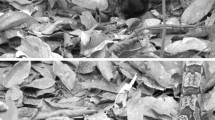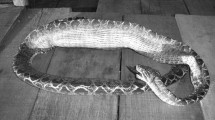Abstract
A juvenile common marmoset (Callithrix jacchus) was attacked by a whitetail lancehead viper (Bothrops leucurus) while playing with other group members close to the ground at a site in northeastern Brazil. The attack was almost immediately fatal, but the viper was unable to ingest the body of the marmoset. After approximately 10 min, during which it attempted to swallow the marmoset a number of times, the viper moved away, abandoning the body. While raptors are the principal predators of callitrichids, this record reinforces the relative vulnerability of these primates to snakes in comparison with other platyrrhines, although the small number of recorded events precludes a more definitive analysis of the phenomenon.
Similar content being viewed by others
References
Altmann J (1974) Observational study of behavior: sampling methods. Behaviour 49:227–267
Bezerra BM, Barnett AA, Souto A, Jones G (2009) Predation by the tayra on the common marmoset and the pale-throated three-toed sloth. J Ethol 27:91–96
Corrêa HKM, Coutinho PEG (1997) Fatal attack of a pit viper, Bothrops jararaca, on an infant buffy-tufted ear marmoset (Callithrix aurita). Primates 38:215–217
Ferrari SF (1993) Ecological differentiation in the Callitrichidae. In: Rylands AB (ed) Marmosets and tamarins: systematic, behavior, and ecology. Oxford University Press, Oxford, pp 314–328
Ferrari SF (2009) Predation risk and antipredator strategies. In: Garber PA, Estrada A, Bicca-Marques JC, Heymann EK, Strier KB (eds) South American primates: comparative perspectives in the study of behavior, ecology, and conservation. Springer, New York, pp 251–277
Ferrari SF, Lopes MA (1990) Predator avoidance behavior in the buffy-headed marmoset, Callithrix flaviceps. Primates 31:323–338
Foerster S (2008) Two incidents of venomous snakebite on juvenile blue and Sykes monkeys (Cercopithecus mitis stuhlmanni and C. m. albogularis). Primates 49:300–303
Hankerson SJ, Caine NG (2004) Pre-retirement predator encounters alter the morning behavior of captive marmosets (Callithrix geoffroyi). Am J Primatol 63:75–85
Heymann EW (1987) A field observation of predation on a moustached tamarin (Saguinus mystax) by an anaconda. Int J Primatol 8:193–195
Isbell LA (2006) Snakes as agents of evolutionary change in primate brains. J Hum Evol 51:1–35
Kierulff MC, Raboy BE, Oliveira PP, Miller K, Passos FC, Prado F (2002) Behavioral ecology of lion tamarins. In: Kleiman DG, Rylands AB (eds) Lion tamarins: biology and conservation. Smithsonian Institution Press, Washington, DC, pp 157–187
Lledo-Ferrer Y, Hidalgo A, Heymann EW, Pelaéz F (2009) Field observation of predation of a slate-colored hawk, Leucopternis schistacea, on a juvenile saddle-back tamarin, Saguinus fuscicollis. Neotrop Primates 16:82–84
Miller LE, Treves A (2011) Predation on primates: past studies, current challenges, and directions for future research. In: Campbell CJ, Fuentes A, MacKinnon KC, Bearder SK, Stumpf RM (eds) Primates in perspective. Oxford University Press, New York, pp 535–547
Oliveira LC, Dietz JM (2011) Predation risk and the interspecific association of two Brazilian Atlantic Forest primates in cabruca agroforest. Am J Primatol 73:1–9
Rocha JCAG (2011) Distribuição e densidade de populações de Callicebus coimbrai Kobayashi & Langguth 1999, na região do Refúgio de Vida Silvestre Mata do Junco, Sergipe (dissertation). Universidade Federal de Sergipe, São Cristóvão
Shahuano Tello SN, Huck M, Heymann EW (2002) Boa constrictor attack and successful defence in moustached tamarins, Saguinus mystax. Folia Primatol 73:146–148
Stanford CB (2002) Avoiding predators: expectations and evidence in primate antipredator behaviour. Int J Primatol 23:741–757
Acknowledgments
This study was supported by the Brazilian National Research Council, CNPq (project numbers 302747/2008-7, 476064/2008-2, and 374115/2010-9) and the Boticário Foundation (project no. 0846_20092). We thank Dr. Renato Faria for the identification of the snake, Valdineide Santana (IBAMA/SE) and the staff at Mata do Junco for their assistance with this research, as well as an anonymous reviewer for helpful comments on the original version of the manuscript.
Author information
Authors and Affiliations
Corresponding author
Electronic supplementary material
Below is the link to the electronic supplementary material.
Supplementary material 1 (AVI 21157 kb)
About this article
Cite this article
Ferrari, S.F., Beltrão-Mendes, R. Do snakes represent the principal predatory threat to callitrichids? Fatal attack of a viper (Bothrops leucurus) on a common marmoset (Callithrix jacchus) in the Atlantic Forest of the Brazilian Northeast. Primates 52, 207–209 (2011). https://doi.org/10.1007/s10329-011-0260-8
Received:
Accepted:
Published:
Issue Date:
DOI: https://doi.org/10.1007/s10329-011-0260-8




